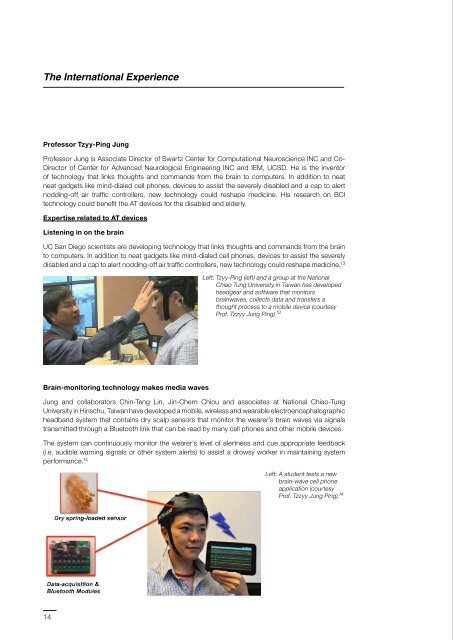Advanced design techniques and tools for the development of ...
Advanced design techniques and tools for the development of ...
Advanced design techniques and tools for the development of ...
Create successful ePaper yourself
Turn your PDF publications into a flip-book with our unique Google optimized e-Paper software.
The International ExperienceThe International ExperiencePr<strong>of</strong>essor Tzyy-Ping JungPr<strong>of</strong>essor Jung is Associate Director <strong>of</strong> Swartz Center <strong>for</strong> Computational Neuroscience INC <strong>and</strong> Co-Director <strong>of</strong> Center <strong>for</strong> <strong>Advanced</strong> Neurological Engineering INC <strong>and</strong> IEM, UCSD. He is <strong>the</strong> inventor<strong>of</strong> technology that links thoughts <strong>and</strong> comm<strong>and</strong>s from <strong>the</strong> brain to computers. In addition to neatneat gadgets like mind-dialed cell phones, devices to assist <strong>the</strong> severely disabled <strong>and</strong> a cap to alertnodding-<strong>of</strong>f air traffic controllers, new technology could reshape medicine. His research on BCItechnology could benefit <strong>the</strong> AT devices <strong>for</strong> <strong>the</strong> disabled <strong>and</strong> elderly.Expertise related to AT devicesListening in on <strong>the</strong> brainUC San Diego scientists are developing technology that links thoughts <strong>and</strong> comm<strong>and</strong>s from <strong>the</strong> brainto computers. In addition to neat gadgets like mind-dialed cell phones, devices to assist <strong>the</strong> severelydisabled <strong>and</strong> a cap to alert nodding-<strong>of</strong>f air traffic controllers, new technology could reshape medicine. 13Brain-monitoring technology makes media wavesLeft: Tzyy-Ping (left) <strong>and</strong> a group at <strong>the</strong> NationalChiao Tung University in Taiwan has developedheadgear <strong>and</strong> s<strong>of</strong>tware that monitorsbrainwaves, collects data <strong>and</strong> transfers athought process to a mobile device (courtesyPr<strong>of</strong>. Tzzyy Jung Ping). 13Jung <strong>and</strong> collaborators Chin-Teng Lin, Jin-Chern Chiou <strong>and</strong> associates at National Chiao-TungUniversity in Hinschu, Taiwan have developed a mobile, wireless <strong>and</strong> wearable electroencephalographicheadb<strong>and</strong> system that contains dry scalp sensors that monitor <strong>the</strong> wearer’s brain waves via signalstransmitted through a Bluetooth link that can be read by many cell phones <strong>and</strong> o<strong>the</strong>r mobile devices.The system can continuously monitor <strong>the</strong> wearer’s level <strong>of</strong> alertness <strong>and</strong> cue appropriate feedback(i.e. audible warning signals or o<strong>the</strong>r system alerts) to assist a drowsy worker in maintaining systemper<strong>for</strong>mance. 14Left: A student tests a newbrain-wave cell phoneapplication (courtesyPr<strong>of</strong>. Tzzyy Jung Ping). 14Destination 2: Institute <strong>for</strong> Neural Computation - University <strong>of</strong> Cali<strong>for</strong>nia,San DiegoLocationSan Diego, USAContactPr<strong>of</strong>essor Gert CauwenberghsObjectivesThe main objectives <strong>of</strong> visiting to Institute <strong>for</strong> Neural Computation at UCSD was to conduct discussions<strong>and</strong> develop international contacts with experts working in <strong>the</strong> area <strong>of</strong> Assistive Technology devices<strong>and</strong> neuropros<strong>the</strong>tics:• Visit <strong>the</strong> Institute <strong>for</strong> Neural Computation at UCSD to gain an underst<strong>and</strong>ing <strong>of</strong> <strong>the</strong> current state<strong>of</strong>-<strong>the</strong>-arttechnology• Visit <strong>the</strong> Department <strong>of</strong> Bioengineering.OutcomesThe Computational Neuroscience specialisation is a new facet <strong>of</strong> <strong>the</strong> broader Neuroscience graduateprogram at UCSD. The goal <strong>of</strong> <strong>the</strong> specialisation is to train <strong>the</strong> next generation <strong>of</strong> neuroscientists with<strong>the</strong> broad range <strong>of</strong> computational <strong>and</strong> analytical skills that are essential to underst<strong>and</strong> <strong>the</strong> organisation<strong>and</strong> function <strong>of</strong> complex neural systems. The Fellow had discussions with some renowned researchersin <strong>the</strong> AT technology <strong>and</strong> BCI arena. The Fellow also had an interesting discussion with <strong>the</strong> co-director<strong>of</strong> <strong>the</strong> Institute <strong>for</strong> Neural Computation, Pr<strong>of</strong>essor Gert Cauwenberghs, <strong>and</strong> discussed key smartassistive technology devices <strong>and</strong> future trends in <strong>the</strong>se technologies. Pr<strong>of</strong>. Gert’s research areas arebriefly discussed below.Pr<strong>of</strong>essor Gert CauwenberghsPr<strong>of</strong>essor Cauwenberghs is Co-Director <strong>for</strong> <strong>the</strong> Institute <strong>for</strong> Neural Computation <strong>and</strong> also Pr<strong>of</strong>essor <strong>of</strong>Biomedical Engineering, UCSD. Pr<strong>of</strong>essor Cauwenberghs pioneered <strong>the</strong> <strong>design</strong> <strong>and</strong> implementation<strong>of</strong> highly energy efficient, parallel microchips that emulate function <strong>and</strong> structure <strong>of</strong> adaptive neuralcircuits in silicon. His research on Very Large Scale Integration (VLSI) technology <strong>for</strong> neurosciencecould benefit <strong>the</strong> AT devices <strong>for</strong> <strong>the</strong> disabled <strong>and</strong> elderly.Left: Students working on researchproject at Pr<strong>of</strong>essor GertCauwenberghs’ Lab.1415

















